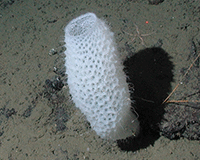Return to 4th Quarter 2019 articles.



The Venus' flower basket (Euplectella aspergillum) is a deep ocean sponge with fascinating properties and an unusual symbiotic relationship with a pair of crustaceans. We call it a romantic get-away inside a sponge.
The Venus' flower basket is classified as a glass sponge because its body is made of silica, which is chemically the same as glass. The silica fibers are woven together to make a hollow, cylindrical vase-like structure. The fibers form a fine mesh which is rigid and strong enough to survive deep underwater.
Glassy fibers thin as a human hair but more flexible and sturdier than human-made optical fibers attach the sponge to the ocean floor. The sponge forms the fibers at ocean temperatures while human-made glass fibers require high-temperature furnaces to melt the glass. Human-made fibers are brittle while the sponge’s fibers are more flexible. Scientists are studying these sponges to find ways to make better fiber-optic cables.
The Venus' flower basket lights its fibers using bioluminescence to attract prey. Even more interesting to us is the relationship these sponges have with some crustaceans called Stenopodidea. The Venus' flower basket holds captive two of these small shrimp-like creatures, one male and one female, inside the sponge’s hollow mesh tube. The captive creatures clean the flower basket by eating the tiny organisms attracted by the sponge’s light and consume any waste the sponge leaves. The sponge provides the crustaceans with protection from predators.
As the crustaceans spawn, their offspring are small enough to escape from the basket and find their own sponge-home where they grow until they are trapped. Because a pair of crustaceans spend their lives together inside the sponge, Asian cultures sometimes use a dried Venus' flower basket as a wedding gift to symbolize “till death do us part.”
The Venus' flower basket and the crustaceans benefit each other by mutual cooperation, which we call symbiosis. One more thing, the bioluminescence comes from bacteria that the sponge collects. This amazing three-way partnership occurs deep under the ocean where humans have only recently explored. We think this romantic get-away inside a sponge is another evidence of divine design, not chance mutations.
Picture credits:
https://en.wikipedia.org/wiki/Venus%27_flower_basket#/media/File:Euplectella_aspergillum_(cropped).jpg
